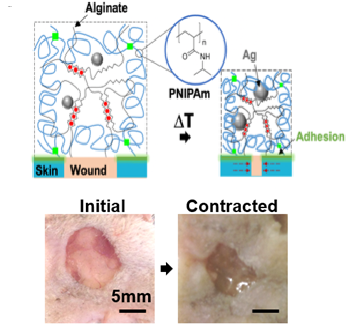Mechanically Active Biocompatible Materials
for Applying Contraction to Cells and Tissues

Inspired by embryonic wound closure, a team at the Harvard MRSEC led by Mooney has developed mechanically active, biocompatible materials that apply contraction to cells and tissues. These active materials consist of thermoresponsive, tough adhesive hydrogels that combine high stretchability, toughness, and strong adhesion (above). They adhere strongly to the skin and actively contract wounds in response to exposure to the skin temperature. In vitro and in vivo studies have demonstrated their efficacy in accelerating and supporting skin wound healing. Finite element models validated and refined the wound contraction performance enabled by these active adhesive dressings. This mechanobiological approach opens new avenues for manipulating biology, and may find broad utility in regenerative medicine, in drug delivery, and as components of soft robotics-based therapies.
David J. Mooney (Bioengineering)
2018-2019 Harvard MRSEC (DMR-1420570)
